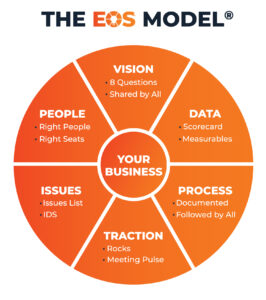
As a business owner, you probably understand the importance of consistency and scalability, but how to achieve them may be less evident. Establishing and implementing clearly defined core processes unique to your business model is an essential part of getting everyone on the same page and positioning your organization for growth.
But what are your core processes, and why do they matter?
They are part of the Process Component™, one of the six key components of the EOS Model®. Your core processes work symbiotically with the other key components and are integral to overall success. You can’t skip them!

If you’re a Visionary, you might view creating processes as too much work and something that will tie you down. In reality, having well-defined processes frees you and everyone in your organization to accomplish more. Yes, belief in and passion for your company, your people, and their limitless possibilities remains important, but it’s not enough.
As Isadore Sharp, founder of Four Seasons Hotels and Resorts, recommends, “Systemize the predictable so you can humanize the exceptional.”
If you find you’re hesitant about devoting time and energy to the Process Component of your business, your sticking point might be a matter of mindset. In their book, “Process! How Discipline and Consistency Will Set You and Your Business Free,” authors Mike Paton and Lisa Gonzalez share that:
So, now that you’re committed to your Process Component, what’s next? Let’s discuss the steps for developing and implementing your core processes.
Inconsistent execution is among the most common problems that fast-growing companies face.
Every organization has a handful of processes that are critical to its success. It’s important to identify them so you can grow your business. Your industry, your company’s products and services, and other factors will determine your core processes. Here are some examples of what they might include:
Once you identify your business’s core processes, document the crucial steps of each from start to finish.
As you do…
Too often, businesses have their processes and procedures scattered across their organization. Once your documentation of each process is complete, package your processes into one central source.
Instead of reinventing the wheel, try this:
Once you’ve documented your core processes, it’s time to share them with everyone in your organization.
You have everything to gain and nothing to lose by identifying, documenting, and implementing core processes. Strengthening your organization’s Process Component in this way will enable you to:
If you’re looking for support in identifying and documenting your core processes, I’m always here to help. Connect with me to learn more about streamlining and scaling your business.
Sources and References:
”Process! How Discipline and Consistency Will Set You and Your Business Free” by Mike Paton and Lisa Gonzalez, pp 1-18